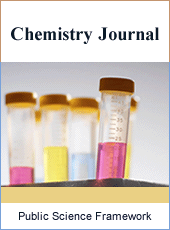Chemistry Journal
Articles Information
Chemistry Journal, Vol.3, No.1, Feb. 2017, Pub. Date: Dec. 13, 2017
Parametric Evaluation of Novel, Basic and Effective Parameters on Performance of Nano Drilling Fluid
Pages: 1-5 Views: 2588 Downloads: 946
[01]
Mohammad Iranparast, Department of Chemical Engineering, Sirjan Branch, Islamic Azad University, Sirjan, Iran.
[02]
Farshad Farahbod, Department of Chemical Engineering, Firoozabad Branch, Islamic Azad University, Firoozabad, Iran.
The objective of designing drilling fluid for extreme and deep environment (HPHT wells) is to develop high performance drilling fluid system in well bore to achieve zonal isolation. The primary objective of drilling fluid is to improve thermo electrical and rheological properties and displacement efficiency of drilling fluid system. The experimental results show the filtration number is decreased from 0.2 to 0.1, approximately when the thickness is changed from 1 to 2 centi meters. In addition according to the standard the thermal penetration is investigated in the different thickness of drilling fluid. The obtained results show, the increasing in the amount of nano particle increases the amount of viscosity of slurry. Also, it seems each extra 0.2% nano oxide increases the viscosity about 0.2 Pa.s from 0.2% to 0.6%. The basic parameters which are effective in determination of drilling fluid performance are evaluated in this study, finally.
Electrical Conductivity, Thermal Conductivity, Thermal Penetration, Drilling Fluid Additives, High Performance Drilling Fluid System, Rheology, Ferric Oxide Nano Particle
[01]
American Petroleum Institute, 2005. Recommended Practice for Testing Well Cements. API Publishing Services, Washington, D. C., pp: 171.
[02]
Banfill, D. and P. F. G. Kitching, 1991. The Yield Stress of Oilwell Cement Slurries. In: Rheology of Fresh Cement and Concrete.
[03]
Bannister, C. E., 1980. Rheological evaluation of cement slurries: Methods and models. Proceeding of the SPE Annual Technical Conference and Exhibition, September 21-24, Dallas, Texas.
[04]
Boukhelifa, L., N. Moroni, E. Spa, S. G. James, S. L. R. Delage, M. J. Thiercelin, G. Lemaire, I. Natl and A. Insa, 2005. Evaluation of cement systems for oil- and gas-well zonal isolation in a full-scale annular geometry. SPE Drill. Comp., 20 (1): 44-53.
[05]
Frittella, B. S. F., B. J. Services and M. Babbo, 2009. Best practices and lessons learned from 15 years of experience of cementing hpht wells in Italy. Proceeding of the SPE/IADC Middle East Drilling Technology Conference and Exhibition, October 26-28, Manama, Bahrain.
[06]
Grinrod, M. and B. Vassoy, 1988. Development and use of a Gas-tight cement. Proceeding of the IADC/SPE Paper No. 17258, Presented at the 1988 IADC/SPE Drilling Conference held in Dallas, Texas, February.
[07]
Guillot, D., 2006. Rheology of Well Cement Slurries. In: Nelson, E. B. and D. Guillot (Eds.), Well Cementing. Texas, Schlumberger, pp: 93-142.
[08]
Harris, K. L. and H. Service, 1991. New lightweight technology for the primary cementing of oilfield casings in cold environments. Proceeding of th International Arctic Technology Conference, May 29-31, Anchorage, Alaska.
[09]
Hodne, H., 2007. Rheological performance of cementitious materials used in well cementing. Ph.D. Thesis.
[10]
Kulakofsky, D. and R. Vargo, 2005. New technology for the delivery of beaded lightweight cements. Proceeding of the SPE Annual Technical Conference and Exhibition, October 9-12, Dallas, Texas.
[11]
Labibzadeh, M., B. Zahabizadeh and A. Khajehdezfuly, 2010. Early-age compressive strength assessment of oil well class G cement due to borehole pressure and temperature changes. Science, 6 (7): 38-47.
[12]
Mehta, P. K. and O. E. Gjorve, 1982. Properties of portland cement concrete containg fly ash and condensed silica fume. Cem. Concr. Res., 12 (5): 587-595.
[13]
Miranda, C. R., R. D. Petrobras, F. Toledo and E. M. R. Fairbairn, 2010. New design of high-performance cement systems for zonal isolation: Influence on porosity, rheological parameters and chemical and mechanical resistance. Proceeding of the SPE Latin American and Caribbean Petroleum Engineering Conference, December 1-3, Lima, Peru.
[14]
Mirza, J., M. Mirza, V. Roy and K. Saleh, 2002. Basic rheological and mechanical properties of high-volume fly ash grouts. Construct. Build. Mater., 16 (6): 353-363.
[15]
Mueller, D. T., R. L. D. Iii, T. Western and N. America, 1991. The versatility of silica fume as an oilwell cement admixture. Proceeding of the SPE Production Operations Symposium, April 7-9, Oklahoma City, Oklahoma, pp: 529-536.
[16]
Nediljka, G. M., M. Davorin and K. Gracijan, 1994. Cement slurries for geothermal wells cementing. Rudarsko-Geološko-Naftni Zbornik, 6 (1): 127-134.
[17]
Shadizadeh, S. R., M. Kholghi and M. H. S. Kassaei, 2010. Experimental investigation of silica fume as a cement extender for liner cementing in iranian oil. Gas Wells, 7 (1).
[18]
Shahriar, A. and M. L. Nehdi, 2011. Anjuman Shahriar Investigation on Rheology of Oil Well Cement Slurries.
[19]
Shahriar, A. and M. L. Nehdi, 2012. Optimization of rheological properties of oil well cement slurriesusing experimental design. Mater. Struct., 45 (9): 1403-1423.

ISSN Print: 2381-7674
ISSN Online: 2381-7682
Current Issue:
Vol. 6, Issue 1, March Submit a Manuscript Join Editorial Board Join Reviewer Team
ISSN Online: 2381-7682
Current Issue:
Vol. 6, Issue 1, March Submit a Manuscript Join Editorial Board Join Reviewer Team
| About This Journal |
| All Issues |
| Open Access |
| Indexing |
| Payment Information |
| Author Guidelines |
| Review Process |
| Publication Ethics |
| Editorial Board |
| Peer Reviewers |


